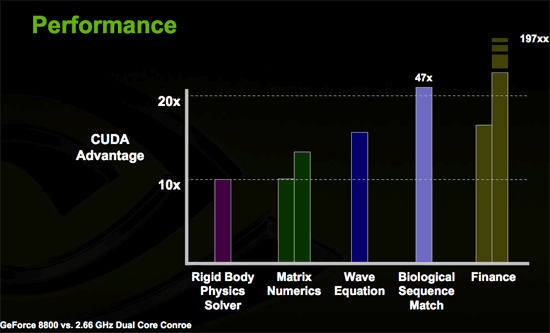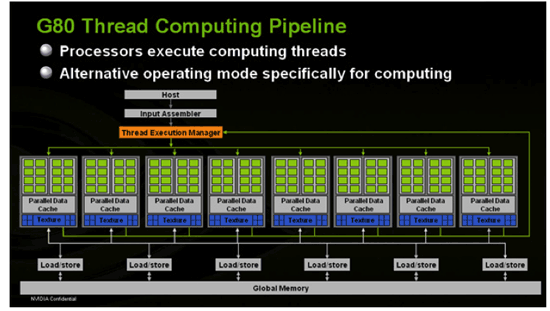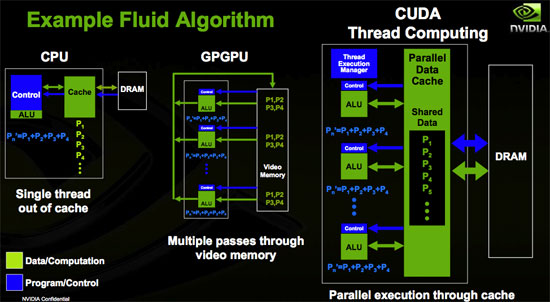NVIDIA's GeForce 8800 (G80): GPUs Re-architected for DirectX 10
by Anand Lal Shimpi & Derek Wilson on November 8, 2006 6:01 PM EST- Posted in
- GPUs
General Purpose Processing
With all the talk about how general purpose G80 is, can we expect it to replace our shiny new quad core desktop processor? This isn't quite possible at this point due to the way most general purpose code uses the CPU. Many dependencies and low parallelism prevent NVIDIA from simply dropping this in a motherboard and running Windows on it.
But there are general purpose tasks that lend themselves well to the parallelism of G80, and NVIDIA is enabling developers to take advantage of this via a technology they call CUDA (Compute Unified Device Architecture).
The major thing to take away from this is that NVIDIA will have a C compiler that is able to generate code targeted at their architecture. We aren't talking about some OpenGL code manipulated to use graphics hardware for math. This will be C code written like a developer would write C.
A programmer will be able to treat G80 like a hugely parallel data processing engine. Applications that require massively parallel compute power will see huge speed up when running on G80 as compared to the CPU. This includes financial analysis, matrix manipulation, physics processing, and all manner of scientific computations.

NVIDIA has written a totally separate driver for G80 that will be used to run compiled C code targeted at G80. The reason they've done this is because the usage model for GPGPU programming is so different from that of graphics. Both the graphics driver and the CUDA driver can be running on G80 at the same time. This may allow programmers to take advantage of CUDA for in game physics on a single card. The driver changes the conceptual layout of the GPU into something that looks more like this:

This design, along with stream output capabilities, allows programmers to treat the GPU like a general purpose data processing engine. Each block of 16 SPs is able to share data with each other and can perform multiple passes on the data without having to write out and read back in from the onboard graphics memory. Developers are given the ability to manage the caches themselves.

Will NVIDIA make an x86 CPU? Most likely not, but we may see NVIDIA produce even more general purpose CPUs for the handheld, CE, integrated markets. NVIDIA may end up becoming a producer of system on a chip solutions utilizing its graphics technology and simply expanding G80 to be more general purpose (and obviously get rid of some of the SPs in order to lower costs).










111 Comments
View All Comments
JarredWalton - Wednesday, November 8, 2006 - link
They did the same thing with the original Halo, porting it (and slowing it down) to DX9. MS seems to think making Halo 2 Vista-only will get people to upgrade to the new OS. [:rolls eyes:]stmok - Wednesday, November 8, 2006 - link
How else are they gonna get gamers to upgrade to Vista? :)(by cornering them into adopting Vista, using DirectX 10.0)
Its sad and pathetic at the same time.
DirectX 10.0 should be a "transitional" solution...That is, it covers both XP and Vista. This allows people to gradually upgrade their hardware, and if they wish, to Vista. What MS is doing now, is throwing everyone (developers and consumers) into the deep end, and expecting them to pay for the changes. (I suspect some would be put off by this, while the majority will continue to accept it...Which is unfortunate).
Great article BTW. Interesting to see the high-end stuff...But I doubt I can afford it in this lifetime!
I have two questions!
(1) Any chance of looking at a triple video card setup?
(I saw a presentation slide which had 2 video cards in SLI, while a third showed something else on screen).
(2) Any idea when the GF8600-series comes?
(mainstream market solution).
yyrkoon - Thursday, November 9, 2006 - link
Great, links arent working ?http://www.gamedev.net/reference/programming/featu...">http://www.gamedev.net/reference/programming/featu...
yyrkoon - Thursday, November 9, 2006 - link
http://www.gamedev.net/reference/programming/featu...">This article was written by a friend of mine back in April after an interview with ATI. Perhaps this will clear some things up.
yyrkoon - Thursday, November 9, 2006 - link
When you break all hardware/software ties to something that has been around for 4-5 years? Its not that easy making it "transitional". From a software perspective, D3D10 is not compatable with XP in the least.I for one, think this is a step in the right direction.
JarredWalton - Thursday, November 9, 2006 - link
Supposedly all of the changes to the WDDM make porting DX10 back to Windows XP "impossible", although I'm more inclined to think the correct term would be "difficult" and you also have to add in "it doesn't fit with MS marketing protocol". WDDM is quite different in Vista however, so maybe there's some substance to the claims.cosmotic - Wednesday, November 8, 2006 - link
On page 9:--Briefly explain what a sub-pixel is in the sentence before--
JarredWalton - Wednesday, November 8, 2006 - link
Due to the size of this article and the amount of time it took to get ready, let me preempt any comments about the spelling and grammar. I am in the process of editing the final document as I read through it, and there are spelling/grammar errors. If they bother you too much, check back in an hour. If you read this an hour from now and you still find errors, then you can respond, though it would be useful to keep all responses in a single thread like this one.Thanks in advance,
Jarred Walton
Editor
AnandTech.com
xtknight - Thursday, November 16, 2006 - link
On p 12 (gamma corrected AA):"This causes problems for thing like thin lines."
acejj26 - Wednesday, November 8, 2006 - link
"If DirectX 10 sounds like a great boon to software developers, the fact that DX10 will only be supported in Windows XP is certain to curb enthusiasm. "I believe this should say "DX10 will only be supported in Windows Vista..."
Not to be rude, but shouldn't the article be edited BEFORE being published??